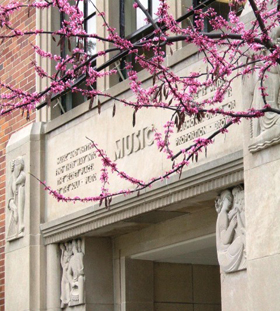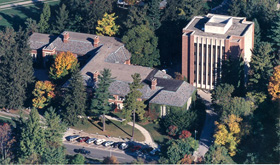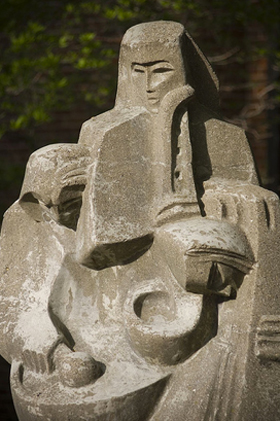About the College
Our History
 From at least 1860, music was among the activities pursued by students at the Agricultural College of the State of Michigan, as Michigan State University was then known. Important dates in the early development of the college include:
From at least 1860, music was among the activities pursued by students at the Agricultural College of the State of Michigan, as Michigan State University was then known. Important dates in the early development of the college include:
- The first campus band was formed in 1870 by Ransom McDonough Brooks, a young Civil War veteran.
- Music was part of the curriculum of the women's program curriculum from 1898 to 1918. A separate music department was created in 1919.
- President Theodore Roosevelt’s visit to East Lansing in 1907 inspired the band to name a faculty member as its head — A. J. Clark, who served until 1918. During his tenure, the band grew from 24 to 60 musicians.
- In 1927, music education became a degree program.
- In 1914, A. J. Clark became the conductor of the new college orchestra.
- In 1916, Fred Able was hired as the director of the Michigan Agricultural College band, chorus, and glee club.
- In 1919, John Siebert Taylor was appointed director of bands. Taylor was known for his march arrangements, which were played by the best bands in the country.
- In 1920, the music department moved into its first permanent home on campus, a house that was remodeled to include a studio, practice rooms, and a recital room.
- In 1927, Lewis Richards of the Royal Conservatory in Brussels was hired to lead the music department. He later hired Leonard Falcone as director of bands.
Jean H. Fickett explored the early history of the College of Music in a doctoral dissertation, "A History of the School of Music at Michigan State University" (MSU, 2003) and in "A History of Music Education at Michigan State University," Journal of Historical Research in Music Education 23:2 (April 2002), 119-135.
The School of Music, which had previously been part of the College of Arts and Letters, became the College of Music in 2007, when the university's Board of Trustees approved the change in recognition of the school's growth and its stature among national music performance and music education programs.

The Music Building and Music Practice Building
Before 1939, music classes met in several different buildings across campus. In that year, the Public Works Administration approved a $90,000 grant for a music building that met less than half of the total cost of $200,000. The remainder of the money was raised from self-liquidating bonds, an idea of Michigan State College president John A. Hannah. (Income from the music program was used to retire the bonds.) The Music Building, Michigan State's first building designed to serve the liberal arts, was dedicated on December 3, 1939. Lewis Richards, then the head of the Department of Music, received congratulatory telegrams from Herbert Hoover, Arthur Schnabel, Sergei Rachmaninoff, Fritz Kreisler, and Sol Hurok, among others.
Adapted from "MSU Campus Buildings, Places, Spaces" by Linda O. Stanford and C. Kurt Dewhurst (Michigan State University Press, 2002): "As a Public Works Administration project, this brick building embodies the exterior design simplicity that emerged in the 1930s. A prominent hipped roof caps the rambling floor plan. Limestone trim visually links the different sections of the building. While the overall massing appears to be a spare interpretation of Collegiate Gothic, the relatively large and metal-framed windows allude to future stylistic developments. Subtle decorative elements are Art Deco. They include streamlined limestone reliefs that enframe the southwest entrance as symbols of dance and performance and introduce the viewer to the world of music within the building. Samuel Cashwan, who supervised the Michigan sculpture program for the Works Progress Administration, produced these reliefs to make art a part of  people's lives. In the courtyard, Cashwan's Cubist "Three Musicians" (shown at right) perform. This cast-concrete sculpture includes a bass player, drummer, and saxophonist. It was one of a pair of sculptures the Class of 1939 gave to flank the stage of the Art Deco band shell of 1938, which once occupied the grounds where Bessey Hall now stands."
people's lives. In the courtyard, Cashwan's Cubist "Three Musicians" (shown at right) perform. This cast-concrete sculpture includes a bass player, drummer, and saxophonist. It was one of a pair of sculptures the Class of 1939 gave to flank the stage of the Art Deco band shell of 1938, which once occupied the grounds where Bessey Hall now stands."
"The Music Practice Building, built in 1968, is a tall, International Style design that stands unadorned amidst the trees on the periphery of the oak opening. Its brick and concrete exterior complements its "partner" across the courtyard, the Music Building. Prominent concrete projecting piers heighten the overall square plan and, on a sunny day, transform the facades into a dramatic interplay of light and dark verticals. The Music Practice Building is best seen from West Circle Drive by looking north across the lush grotto known as Sleepy Hollow. Until the early twentieth century, a wooden wagon bridge crossed this grotto or ravine, most likely in the same way that West Circle Drive does today. In Sleepy Hollow, an extension of the W. J. Beal Botanical Garden, the special growth requirements of acid soil plants are met. In the 1850s, clay was dug here to make the brick for the first campus building, College Hall. Several decades ago, students gathered here to burn freshman caps and senior textbooks. When classes are in session, it is possible to walk on this part of campus and hear a variety of musical sounds before it is possible to actually see either the Music Practice Building or the Music Building through the trees."
A New Beginning for Music Facilities
Significant renovations to the auditorium in the Music Building were completed in 2012. The venue now known as Cook Recital Hall in honor of Byron and Dee Cook, longtime supporters and friends of the college, features state-of-the-art acoustics. Extensive renovations to Fairchild Theatre in the MSU Auditorium were completed two years later. These two stages became sought-after places for artist-faculty, students and guest artists to perform due to their superior sound quality, and audiences immediately recognized a greatly improved concert experience. By summer of 2018, the college gained final approval for the most significant improvement in music facilities at MSU since the addition of the Music Pracitice Building in 1968 - the construction of the Music Pavilion, a project consisting of 37,000 square feet of new space and 8,500 square feet of renovated space in exisiting facilities. The project is expected to be completed in April 2020.
Emeriti Faculty
Since its beginning, the Michigan State University College of Music has attracted some of the world's leading teachers, scholars, and performers to its faculty, as demonstrated in these short profiles.


